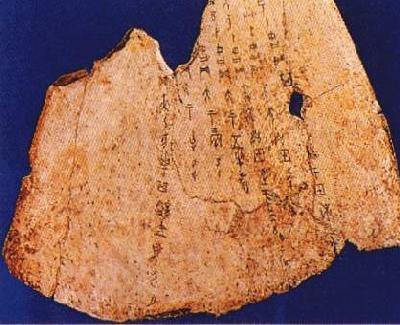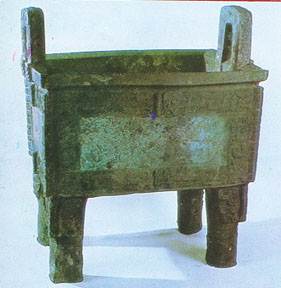 |
| Script on animal bones and tortoise
shells |
The Shang Dynasty (17th-11th century BC) is the
second slave dynasty in Chinese history. With its first capital established in
Bo, the Shang moved its center of activities several times, finally settling in
Yin (present-day Xiaotun in Anyang County, Henan Province) under the king of Pan
Geng. Hence, the Shang Dynasty is also called the Yin Dynasty, consisting of 31
kings who belonged to 17 generations.
The Shang basically followed the system of a
hereditary monarchy with the younger brother succeeding the elder one at first,
and gradually developing into the eldest-son succession system in the later
period of the Shang. This laid an important foundation for the patriarchal clan
system adopted by the following Zhou Dynasty (11th century-256BC).
 |
| Simuwu Rectangle Ding (110 cm long and 78cm
wide) |
The Shang is very famous for its augury and the
existing Jiaguwen (inscriptions on animal bones and tortoise shells) is
the witness of augury of the time. The ruling area of the king was limited to a
small central area, with surrounding areas belonging to princes of the royal
family and other tribes. At that time, the centralization of state power had not
yet been developed.
The Shang Dynasty inherited the tradition of
astronomical phenomena observation. Many inscriptions on animal bones and
tortoise shells discovered in Yin ruins record astronomical phenomena, including
the description of the solar and lunar eclipses, stars, and the earliest record
of new stars in the world.
 |
| Square Zun with the design of four sheep heads on four
sides |
Based on the Xia calendar, the Shang used a lunar
calendar that was combined with the solar year through the addition of an
intercalary month once every few years to make up the difference between a year
of 12 lunar months and a solar year. The number of days in a month was fixed at
30 for a long month and 29 for a short one. The intercalary month was added at
the end of the year as a 13th month. This is the origin of an intercalary month
in Chinese history, which laid down the foundation for the traditional Chinese
calendar. Compiling calendars had since experienced many changes and the
calculations have become increasingly exact.
Sets of musical instruments have been
unearthed in the Yin ruins, including pottery Xun (an egg-shaped wind
instrument), stone Qing (chime stone), copper bell, copper cymbals and drum. One
big stone Qing with an embossment of a staring tiger was discovered in a tomb in
Wuguan Village in Anyang of Henan Province. It is the earliest existing large
musical instrument and also a piece of sculpture with high artistic
value.



